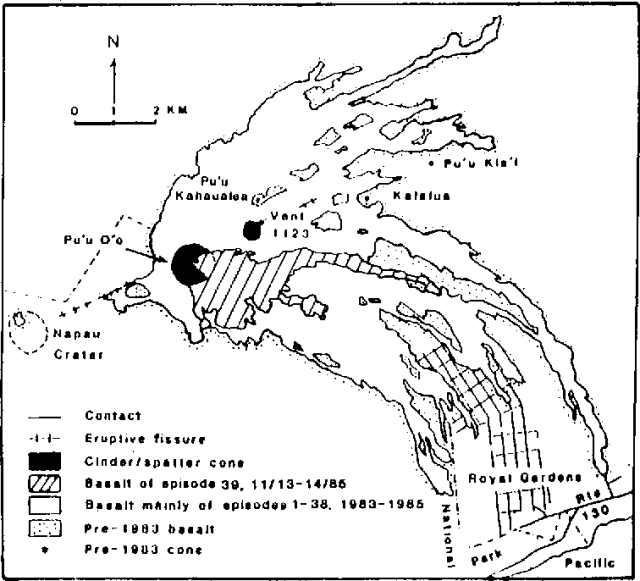Report on Kilauea (United States) — November 1985
Scientific Event Alert Network Bulletin, vol. 10, no. 11 (November 1985)
Managing Editor: Lindsay McClelland.
Kilauea (United States) Episode 39 includes S-flank vent activity
Please cite this report as:
Global Volcanism Program, 1985. Report on Kilauea (United States) (McClelland, L., ed.). Scientific Event Alert Network Bulletin, 10:11. Smithsonian Institution. https://doi.org/10.5479/si.GVP.SEAN198511-332010
Kilauea
United States
19.421°N, 155.287°W; summit elev. 1222 m
All times are local (unless otherwise noted)
EPISODE 39
"Kīlauea's eruption continued in November with the 39th eruptive episode. From 12-13 November, the magma column was within a few meters of the conduit rim and spattering nearly continuously. At about 0530 on 13 November, three small vents opened on the S flank of Pu`u `O`o. Two of these vents remained active through the day and produced a pahoehoe flow that extended approximately 600 m beyond the base of Pu`u `O`o.
"The summit of Kīlauea began to deflate on 13 November at 1430. An hour later, activity at the main Pu`u `O`o vent increased, and a low fountain began to feed a thin pahoehoe flow. The fountains gradually increased in height, reaching 415 m by 1925. The vents on the S side of the cone probably died at about the same time. The high fountains continued until 0124 the next morning and produced an aa flow that extended 6 km ESE of Pu`u `O`o (figure 39).
 |
Figure 39. Lava flows produced by the E rift zone eruption since January 1983. Episode 39 flows are marked by diagonal lines. |
"Summit subsidence continued until 14 November at 0330, with a total loss of 13.9 µrad recorded by the summit tiltmeter. By the end of November, the summit had regained 9.6 µrad.
"Harmonic tremor associated with episode 39 increased gradually from 13 November at 1610, peaked in amplitude between 1725 and 0100, and decreased at 0126 on 14 November. Following episode 39, harmonic tremor persisted at background levels in the E rift zone near Pu`u `O`o."
Geological Summary. Kilauea overlaps the E flank of the massive Mauna Loa shield volcano in the island of Hawaii. Eruptions are prominent in Polynesian legends; written documentation since 1820 records frequent summit and flank lava flow eruptions interspersed with periods of long-term lava lake activity at Halemaumau crater in the summit caldera until 1924. The 3 x 5 km caldera was formed in several stages about 1,500 years ago and during the 18th century; eruptions have also originated from the lengthy East and Southwest rift zones, which extend to the ocean in both directions. About 90% of the surface of the basaltic shield volcano is formed of lava flows less than about 1,100 years old; 70% of the surface is younger than 600 years. The long-term eruption from the East rift zone between 1983 and 2018 produced lava flows covering more than 100 km2, destroyed hundreds of houses, and added new coastline.
Information Contacts: C. Heliker, R. Hanatani, R. Koyanagi, HVO.

